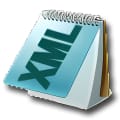

- Xml notepad 2011 deutsch code#
- Xml notepad 2011 deutsch free#
After you’ve opened a new tab in Chrome, drag the XML file over there. XML files can be opened with almost any browser. If you simply want to view the data in an XML file, you have no problem doing so. XML Notepad can be exited by selecting Exit from the File menu. Change the type of a node by highlighting it. The child element for Book can be added by right-clicking the folder icon next to the book and pointing to Insert. To insert a value for this attribute, highlight ID and type Bk101 into the TextBox in the Values pane. To add elements, attributes, comments, and text to the document, you can create a tree structure in the left pane and enter values in the corresponding text boxes in the right pane. This tool enables you to graphically display the XML structure of your data in a tree structure. You can edit and create XML documents in XML Notepad. If you want to edit the XML code, you can do so by selecting the “Edit” tab.
Xml notepad 2011 deutsch code#
Once the file is open, you can then view the XML code by selecting the “View” tab at the top of the Notepad window. To run an XML file in Notepad, simply open the file using the program. When you have finished making your changes, you can save the XML file by selecting File > Save from the menu. From here you can edit the XML, add new elements, or delete existing ones. The XML document will be displayed in the main window. Once downloaded and installed, XML Notepad 2007 can be opened by double-clicking on an XML file, or by opening the program and then selecting File > Open from the menu. It can be downloaded from the Microsoft website.
Xml notepad 2011 deutsch free#
XML Notepad 2007 is a free Microsoft tool for editing XML. This article provides a brief introduction to using XML Notepad 2007. Help #īring up the help contents and index as well as the About Dialog.XML Notepad 2007 provides a simple intuitive interface for viewing and editing XML documents. Provides a "New window" command for launching another instance of XML Notepad. Only those insert operations that result in well formed document will be enabled. You can insert before, after or as a child of the currently selected node. Launches XML Diff which compares the current document you are editing with another document on disk and displays the results.Ĭontains commands for inserting various node types.
Next Error Navigate to the next error in the list of errors. The XmlStats.exe program is in the current working directory so you can play with it further. Opens a command prompt with the results of running XmlStats.exe on the current file. Source Show the current XML document in text form using "Notepad". Status Bar Toggle the visibility of the status bar. See "Collapse" item on the context menu if you just want to collapse the selected node. Collapse all Collapse all expanded nodes in the entire tree (except the root node). See "Expand" item on the context menu if you just want to expand the selected node. Expand All Expand all collapsed nodes in the entire tree. 
Allows you to instantly find what you type.
Right so it becomes the last child of the previous sibling. Left Before the parent if this is the first child, otherwise after the parent. Down After the next sibling, or after the parent if there is no next sibling. Up Before the previous sibling, or before the parent if there are no previous siblings. Expand XIncludes Expand all XInlcude elements with the contents of the XML documents they point to. Goto Definition Open the selected XInclude or open the XML Schema that defines the selected node in a new instance of XML Notepad. Change To Changes the selected node to the specified node type. Duplicate Clone the selected node (and its children) and insert the clone as the next sibling. Rename Enter edit mode on the current element or attribute so you can rename it (or type Enter key). This makes it easy to build a list of nodes that have the same type. Insert Insert a new node of the same type (element, attribute, processing instruction, comment, etc) as the currently selected node. Paste Parse the XML in the clipboard and create new nodes in the tree under the selected node. Copy Copy the selected node to the clipboard (and its children). Cut Copy the selected node to the clipboard (and its children) and remove that node from the tree. The edit menu contains the following commands: Recent Files This menu provides quick access to the last 10 XML documents you've edited. Export Errors Save the contents of the Error List in an XML format. Save As Save the current document to a different file name on disk. Save Save any edits you've made to the file disk. Reload Discard any edits you've made and reload the file as it exists on disk. Open Open an XML document for editing. The file menu contains the following commands: XML Notepad provides the following menu commands.






 0 kommentar(er)
0 kommentar(er)
